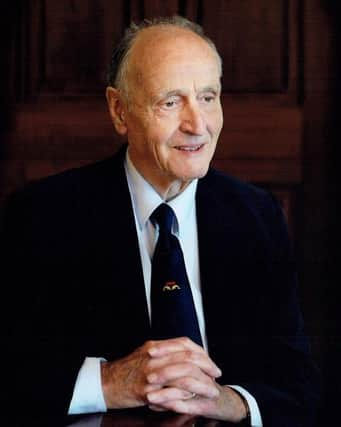Obituary: David Scarth Ritchie, scientific instrument designer


David Scarth Ritchie was born in Edinburgh to Professor William and Madeline Ritchie. He was the second of four remarkable siblings, who all survived the war and multiple life events to live into their eighties and nineties. David was the last one standing.
He was educated at The Edinburgh Academy from Denholm Green through the prep and senior school – leaving in 1941.
Advertisement
Hide AdAdvertisement
Hide AdHe planned a career in medicine but had a last minute change of mind and went to Cambridge to study mechanical sciences.
He won a rugby blue and captained the Corpus Christi side. Later in life, he played for a combined services side at Murrayfield.
Whilst in the officer training corps at Cambridge, he had to defend a bridge across the Cam, in case of invasion. A pontoon was built with the Royal Engineers to cross the Cam and it promptly sank!
After Cambridge, David joined the Royal Navy – training at Greenwich College. He served on HMS Berwick and HMS Newfoundland with the British Pacific Fleet in China, Japan (where he climbed Mt Fuji) and Australia as an Instructor Lieutenant. He was in Australia at the end of war with Japan.
In 1947 he married Heather McLennan, daughter of Brigadier KAT McLennan, at St Giles Cathedral in Edinburgh.
After leaving the navy, David worked as a weather forecaster -– based not far from what is now Stansted Airport.
He joined Barr and Stroud in Glasgow, in 1948, working his way up from scientific instrument engineer to company director with responsibility for all research.
At one point, David was in charge of a team of 600 technical staff. He invented a number of optical and electronic systems some of which were patented.
Advertisement
Hide AdAdvertisement
Hide AdAlthough his primary work was with periscopes, he was also involved with the development of range finders.
After retiring from Barr and Stroud in 1986, David took on a number of roles including chairing a Scottish Education Department survey on industrial liaison, becoming a governor at Paisley University and was appointed Visiting Professor in Management Technology Innovation at Strathclyde University.
He was made an elder of Prestonkirk, East Linton and worked on a number of projects, including the transfer of the stained glass windows from St Andrews church in East Linton.
David was an active member of the East Linton History Society and Saltire Society.
His wife Heather died in 1987. In 1988, in the lunch queue at a conference, he met Astrid Huggins (nee Chalmers Watson). They were married in 1989 and enjoyed 31 years of marriage.
In 1987, he was approached by Sidney Ross to become a Trustee of the James Clerk Maxwell Foundation, which was formed in 1977 to honour and promote the memory and scientific contributions of James Clerk Maxwell – one of Scotland most eminent physicists.
Over the years, David filled many roles for the Foundation, showing great energy and dedication.
In 1993, as Director of Development for the Foundation, he master minded the raising of £500,000 to buy 14 India Street – a New Town house where James Clerk Maxwell was born.
Advertisement
Hide AdAdvertisement
Hide AdHe worked tirelessly in writing hundreds of letters to individuals, trusts and charities to seek contributions.
The foundation succeeded in raising the necessary funds, thereby establishing Maxwell’s legacy in Edinburgh.
David was elected a Fellow of the Royal Society of Edinburgh in 1997. He donated a fine portrait of Clerk Maxwell which now hangs in the Maxwell Room in the RSE, along with a hologram of the Maxwell statue, situated in George Street.
In 1999 David founded the James Clerk Maxwell Cancer Research Fund with a group of oncologists.
He was an able watercolour artist and played the cello and piano. Gardening was also a major love and he created or improved several gardens, including Southwood, Newbyth.
David is survived by Astrid, four children, two stepdaughters, ten grandchildren, three step-grandchildren and 14 great-grandchildren.
Alastair W S Ritchie